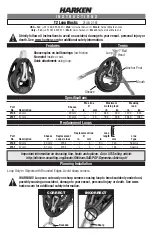
14
be checked for wear or damage.
Also check it for the legibility of the product label-
ling! The use of damaged components or compo-
nents subjected to a fall must be discontinued at
once. If there is only the slightest doubt, the pro-
duct needs to be retired or subjected to testing and
by a competent person.
When using the equipment in occupational health
and safety to EN 365, it must
be checked at least
every 12 months by a duly qualified person
strictly observing the instructions, or else by the
manufacturer, and it must, whenever necessary, be
replaced. These inspections must be documented
(documentation of equipment; cf. attached Inspec-
tion Sheet). Refer to national regulations for inspec-
tion intervals.
This inspection must comprise:
�
Inspection of the general condition: age,
completeness, dirt, correct composition.
�
Inspection of the labels: Does it exist? Is it
legible? (CE marking, manufacturing date, serial
number, EN standard, manufacturer, designation
of product)
�
Inspection of the individual parts for mechanical
damage such as cuts, cracks, notches,
abrasion, deformation, ribbing, curling,
squashing.
�
Inspection of all individual parts for damage
caused by heat or chemicals, such as fusion or
hardening.
�
Inspection of the metal parts for corrosion and
deformation.
�
Inspection of the completeness of the end
connections, seams, knots.
�
Inspection of all harness closures for their flaw
less function (e.g. proper locking)
Here, too,
if there is the slightest doubt, the pro-
duct must be with drawn or inspected by an expert.
MAINTENANCE
Only the manufacturer is permitted to carry out re-
pairs.
SERVICE LIFE
Only if the rope is rarely used (one week a year) and
stored correctly (see the section on transport, sto-
rage and cleaning) can its useful life (service life) be
up to 10 years from date of manufacture. Intensive
use reduces the life span significantly. Actual useful
life depends solely on the condition of the product
which is influenced by various factors (see below).
The lifespan could be as short as first use under
extreme conditions, or even less if damaged (e.g. in
transit) prior to first use.
Explicitly, it is not possible to make a generally valid
statement about the service life of the product, as it
will depend on various factors such as (incomplete
list!) storage conditions, UV radiation, intensity and
frequency of use, maintenance/care, climatic influ-
ences such as temperature, moisture, snow; envi-
ronments such as salt, sand, chemicals, ...
Mechanical wear or other influences such as the
effects of sunlight seriously reduce useful life. Blea-
ched or rubbed fibres / belt straps, discolouring and
hardening are a sure sign that the product should
be withdrawn from use.
We expressly refrain
from making any general
statements about the useful life of the product,
since it depends on a variety of factors such as UV
light, the type and frequency of use, treatment, the
effects of weathering such as snow, the environ-
ment such as salt, sand, battery acid, and many
more factors. In general, if for whatever reason, no
matter how insignificant, the user is not certain that
the product satisfies the requirements; it must be
withdrawn from use and inspected by an expert.
Any product that shows signs of wear should be
withdrawn.
Generally, products made of plastics or textiles
must be retired after 10 years from their date of
manufacture at the latest.
The product must be replaced without fail after
a fall!!
REGULAR CHECKS / MAINTENANCE /
SERVICE LIFE















































